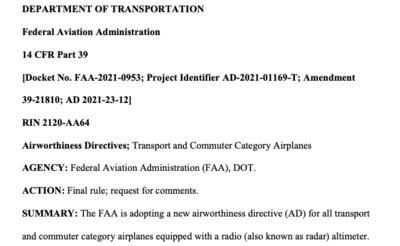Wed, Dec 08, 2021
AFMs to Prohibit Radio Altimeter Use by NOTAMS At Appropriate Airports
The FAA has issued 2 new airworthiness directives regarding the impending (and temporarily postponed) rollout of 5G networks.

An addition to the approved AFMs for transport and commuter category aircraft will be amended with updated radio altimeter flight restrictions, for select locations to be named by NOTAMs for the area. The agency also invites aeronautical, avionics, and telecommunications companies to help identify exactly which areas are most likely to develop signal interference or altimeter errors. The agency is on a shorter timeline than usual, noting that a number of 5G network providers are due to begin service in January 2022. The public has 45 days to review and comment on the changes, with the amendments effective once published to the federal register.
The FAA plans to use the data provided by telecomms providers to determine exactly which C-Band base stations or similar technology that would impact altimeter operation at the appropriate airports. Of course, the change in usable instrumentation could significantly alter approach procedures, noting "these limitations could prevent dispatch of flights to certain locations with low visibility, and could also result in flight diversions."

Directive 01169-T specifically notes that although the normal, lengthy issuance process has been omitted, "the FAA has found that the risk to the flying public justifies forgoing notice and comment prior to adoption of this rule because radio altimeter anomalies that are undetected by the aircraft automation or pilot, particularly close to the ground (e.g. landing flare), could lead to loss of continued safe flight and landing. The urgency is based on C-Band wireless broadband deployment, which is expected to occur in phases with operations beginning as soon as January 5, 2022. Accordingly, notice and opportunity for prior public comment are impracticable and contrary to the public interest."
More News
From 2023 (YouTube Version): Legacy of a Titan Robert (Bob) Anderson Hoover was a fighter pilot, test pilot, flight instructor, and air show superstar. More so, Bob Hoover was an i>[...]
Get The Latest in Aviation News NOW on Instagram Are you on Instagram yet? It's been around for a few years, quietly picking up traction mostly thanks to everybody's new obsession >[...]
Aero Linx: B-52H Stratofortress The B-52H Stratofortress is a long-range, heavy bomber that can perform a variety of missions. The bomber is capable of flying at high subsonic spee>[...]
Altimeter Setting The barometric pressure reading used to adjust a pressure altimeter for variations in existing atmospheric pressure or to the standard altimeter setting (29.92).>[...]
"Knowing that we play an active part in bettering people's lives is extremely rewarding. My team and I are very thankful for the opportunity to be here and to help in any way we ca>[...]
 Classic Aero-TV: Remembering Bob Hoover
Classic Aero-TV: Remembering Bob Hoover ANN FAQ: Follow Us On Instagram!
ANN FAQ: Follow Us On Instagram! ANN's Daily Aero-Linx (05.15.24)
ANN's Daily Aero-Linx (05.15.24) ANN's Daily Aero-Term (05.15.24):Altimeter Setting
ANN's Daily Aero-Term (05.15.24):Altimeter Setting Aero-News: Quote of the Day (05.16.24)
Aero-News: Quote of the Day (05.16.24)




